by Keith BohnIntroduction
The purpose of this guide is to allow most any amateur interested in vintage machinery to gain some of the basic information required to start and complete a restoration. With so many different makes, models and machine types it would be nearly impossible to cover everything here. If you are looking for specific information please feel free to take part in the OWWM discussion group. In the mean time, this guide can act as your jumping off point and hopefully get you started.
1 - Getting Started
The very first thing you will need to do is, find out the name, rank and serial number of the machine. This will aid you later when questions come up and for finding a manual.
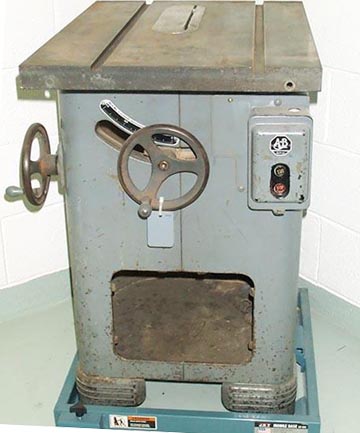 This Unisaw is nearly identical to every Unisaw ever built. A parts drawing for a newer saw was used along with one vintage to the saw during its restoration. |
2 - Pre-Tearing Down
Prior to taking the machine apart, take pictures and/or make sketches. Regardless of whether you have a manual in hand you will use these later when re-assembling the machine. At the very least you'll want these to show to friends and family as a document of what a sad bastard it was and what a glorious machine it became under your watch.
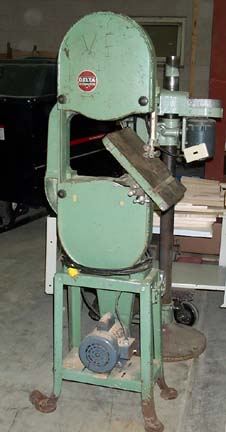 No one would ever believe this saw could have ever been green but people will wonder why after it's done. |
A word now about still pictures. You do not need pictures with the cat, the dog, the potted plants or the rest of your shop in the frame. Fill the frame with the item being photographed. It will not break your camera to do this and you will thank me later. Take close up pictures along the way showing the sub-assemblies. Take pictures from all sides and angles. Film is cheap compared to the frustration of wishing you’d have taken more pictures. It also wouldn’t hurt to take a video tape of the machine. Walk slowly around it, zoom in and out and repeat. Even if you only end up with stiff competition for Somenex it might save you six months from now during re-assembly.
3 - The Tear Down
At this moment in time gather the following items.
- Baggies
- Sharpie Permanent Marker
- Plastic Bins
- Cardboard Boxes
- Paper Tags with Strings
It's probably self evident what we'll be doing with these but I cannot stress enough the importance of cataloging each and every piece removed from the machine. When I'm stripping down a machine I try and keep sub-assemblies together for as long as possible. For instance, the lower base casting for a bandsaw does not need to be fully disassembled. It can be set aside for later disassembly.
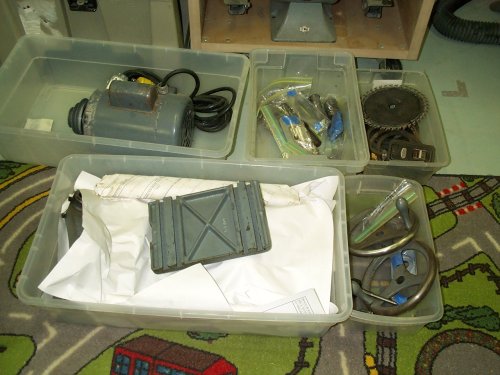 Parts here have been bagged, cataloged and placed into plastic tubs to help keep track of them. |
Some tools you'll need for this phase are as follows:
- Everything In Your Tool Box
- Brushes
- Pin Punches
- Gear Puller
- Every Tool You’ve Wanted But Could Not Justify Till Now
I'm assuming your tool kit already contains the basics like wrenches, socket set, hammers, screwdrivers and the like. For the brushes I like to have an assortment of stiff brushes, wire brushes and just plain old paint brushes. It's also good to have a shop vac. An air compressor is a must.
4 - Put Together A Game Plan
About five minutes after buying a vintage machine the typical buyer begins to form a game plan of how to go about restoration. There are a few ways to tackle this job.
- Tear the whole thing down bit by bit, piece by piece, clean everything up at once, re-paint and reassemble. This is not for the faint of heart especially when you find yourself looking at a few hundred parts.
- Tear down the machine into manageable components and work from the ground up. This means starting with the stand, working up to the part or assembly that fastens itself to the stand until you've gotten all the way to the table. This method can be tedious but there is a trade off with your sanity. I also favor this for storage reasons. A machine broken down into bite size chunks can be rat holed better.
- This involves a mix of both. Consider that you'll probably only want to visit the sand blaster once. It makes sense to get those pieces ready for blasting and get that over with. Cleaning metal parts, priming all the parts and finally painting all the parts at once will save you some time and effort. Personally, I'm in it for the fun so time means little to me.
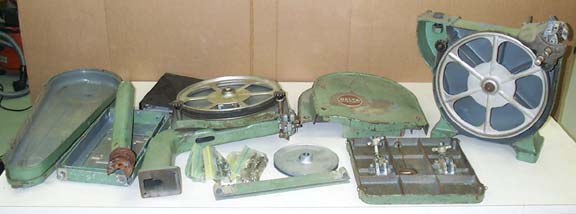 This saw was taken apart to easily get it into a basement shop. The baggies contain parts for the base. |
Now you're ready to tear into the machine. Start by disassembling whatever major components there are. I'll not say much about this, as this is a generic tear down guide. As you are removing things give them a good brushing to remove any dirt or grime. You don’t need to be able to eat off the parts, just get them cleaner. You will at this time discover parts that are broken or need replacing. Order parts (if available) as soon as possible. Consult a machinist if there are parts that need to be fabricated.
Set aside the parts after marking them. I find heavy plastic totes good for segregating assemblies and things that need to stay together. The baggies work nicely for nuts, screws and other small parts or for parts you don’t want to become damaged.
I pick up casters whenever I can from garage sales and estate sales. These are then mounted to scraps of plywood. Larger components or tubs are stored on these for easy moving about the shop and rat holing.
5 - Tags & Decals
Tags and decals should be saved at all cost. Decals, the most fragile, should be spared cleaning and have to be masked off when spraying. Tags are sometimes riveted to the machine or held in with quick spiral shaft drive screws. The former can be ground off from the back and replaced later with a suitable replacement. With the latter you might find that the manufacturer drilled through the casting to secure the tag in which case it's only a matter of driving the screw out with a small pin punch. I have not been successful with removing spiral shaft screws from the front. There is one technique employed by an OWWMer where he uses a sharp putty knife to coax the screw free.
The restoration of tags is an art form, which I am unable to address at this time. Maybe some day... In the mean time, visit the Used Oliver Machinery site for further information. By the way, Jeff Hoffman, of Walker-Turner restoration fame, notes original tags as, icing on the cake and sprinkles on your Dairy Queen. I have to agree.
6 - The Cleaning
Once you've started freeing up pieces you can get down to cleaning. I use a mix of chemical and abrasives for this task.
I start with a good hot water soaking followed up with a full strength spraying of Castrol Super Clean. I've tried other degreasers and cleaners but nothing has matched the Super Clean. With the Super Clean on the part I go at it with stiff brushes and Scotch Bright pads. This will typically leave you with a part that has dull paint but clean. Cleaning is followed with a good rinsing in hot water and then the part is blow dried with compressed air. I use hot water to promote evaporation. The hotter the better. By the way, wear heavy insulated rubber gloves. The Castrol will leave flesh looking like hamburger and the hot water rinse can get brutal. Any surface rust that creeps in over the next few days can be cleaned off with a maroon Scotch Bright pad.
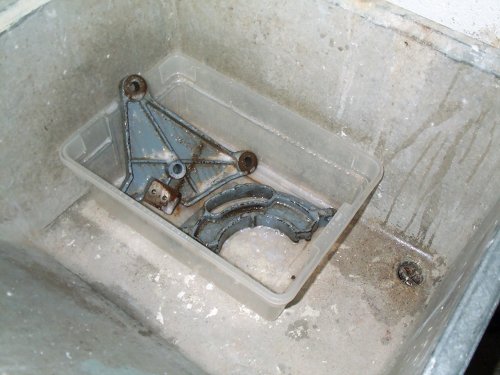 A couple of parts soaking in Super Clean prior to scrubbing. |
Occasionally I'll come across a machine used in a metal shop or one that's completely covered with a build up of grease, grime and oil. I've found a good pre-soak in a hot water bath with the liquid detergent Dawn will cut a lot of this grime.
I save using wire wheels for screw threads, removing paint from cast iron or parts that won't be seen. I don't like the finish they leave on bright metal parts. That's just me.
For machined surfaces I will sometimes brighten them up using a Scotch Bright wheel with a 1/4" mandrel. The Scotch Bright isn't so abrasive that you'll take off metal but I do take it easy for critical parts that have to fit within another part.
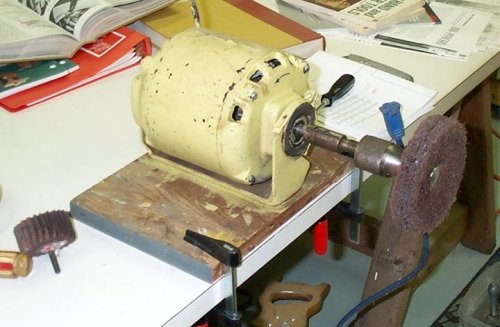 This Scotch Bright wheel quickly cuts through rust, tarnish and grime. The smaller wheel give a little more polished finish. |
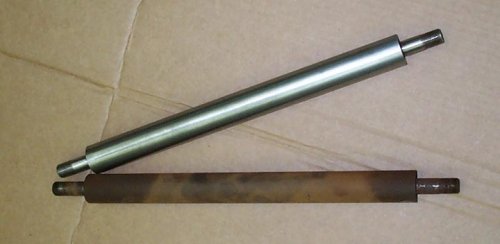 A before Scotch Bright and after Scotch Bright picture. Can you tell which is which? |
For larger items like cast iron covered in many layers of paint I rely on sand blasting or a wire wheel. Prior to blasting I do give the part a degreasing and knock off any loose paint or scale. Tape off the machined surfaces with two layers of duct tape to prevent damage. The blaster I use is a self-service that charges by the hour. Sand blasters can be gotten for home use though. If you use a wire wheel, wear a respirator. Most old paint is lead based.
7 - Table Surfaces
Table surfaces, to me, are one of the most important items. OWWM member Keith O’Boyle turned me onto a great trick of scraping the surface using a single blade razor in a handle. This will take up the paint chips, stuck on stuff and rust. It will leave behind a very smooth usable surface. It will not take out pitting though. I follow this up with a hook and loop Scotch Bright disk on a random orbital sander using WD-40 as a lubricant. Hook and loop non-woven Scotch Bright disks are available from industrial suppliers. Contact McMaster?-Carr for their Hook 'n Loop Surface Blending Disks if you cannot locate them locally. By the way, I'm not going for showroom shiny but rather something with some patina left on it. In very extreme cases you may want to consider having the top re-machined using a Blanchard grinder. Consult with a local machinist for this work. I should also note I clean the tables prior to painting. This allows me to be a little sloppier than I would had time been spent on the piece making it pretty again.
8 - Repair
After all the dirt, grime, grease and old paint is gone you can finally set about accessing the damage done over the years. No matter how hard you try; you cannot see a machine’s condition until the gunk is off.
Broken cast iron can be welded but be sure the welder knows his stuff. We have a local firm called Metal Surgery. I’ve not had a need for them yet but if I do... Consult past messages on the OWWM forum to familiarize yourself with this technique.
Holes in sheet metal can be filled. I've used JB Weld for this and have come away not being able to find the original blemish. There are other fillers on the market. By the way, I let minor dents go. A larger dent can be knocked back to flat but I would never go for concourse condition when it comes to sheet metal work.
Do a final assessment of the parts you need and get them ordered or have a machinist fabricate them. Keep in mind that a shop fabricated fix isn't the worst thing in the world. MDF can paint up as shiny as any sheet metal.
9 - Taping and Masking¶
Three words. Blue masking tape. Accept no substitute. Best thing since sliced bread. I tape off all the parts that shouldn’t be painted. Where possible I try to hold a line with the tape but generally I trim the tape with a single edge razor. By the way, I buy razors by the hundred box.
Marty Escarcega turned me onto a method of applying grease to the areas he doesn’t want painted. Where I find myself using grease the most is for tapped holes and areas like trunnion teeth. In other words, areas that are a real pain to apply masking tape to.
10 - Primer and Paint¶
Let me start with, I am not a painter. On the other hand, we're only talking about woodworking equipment. Don't get me wrong. I like to see the job done well, but we aren’t talking concourse condition Corvettes.
Some time along the way you will probably have noticed your machine was either, A) sporting it's original, yet dulled, coat of paint, or, B) been painted so many times it was like a trip to Sherwin Williams. If you’re lucky enough to be stuck with *A* you might only need to take a small piece to the paint store and have it scanned for the paint formula. If you were unfortunate to find *B* don’t be discouraged. Many times I've found that past paint jobs only consisted of a "brush and run" where only the exterior or parts that show were painted. This means that somewhere on the machine you will find the virgin color. Specifically, look inside the cabinet or where two parts were machined, painted and joined together with screws. Somewhere on your machine is the original color. You will find it.
For a sprayer I’ve found a Critter to work wonderfully. These are probably the bottommost of the bottom of the line in sprayers. Still, it works. I start by laying on a full coat of Rustoleum primer to all surfaces. This is followed up after drying with a scrub down with the Scotch Bright pad. This step helps to give the primer tooth for the top coats. I am still learning my spray technique. I can tell you, follow what everyone says about staying the same distance away from the objetc. Start the gun prior to hitting the object and don’t let off till you are past it. Spray on a light coat and let it sit and tack up. Then follow up with a *heavier* coat.
One thing to note about painting. If it weren’t for painting, almost any machine could be tore down, cleaned up and reassembled in your spare time over the course of a week by most human beings. Waiting for paint to dry will double or triple the time required. Painting requires planning.
11 - Reassembly
The day has come. All the parts that should be shiny bright are and you can't wait to start putting it all back together. Get out the pictures, sketches and video tapes. Review where you were and get to it.
One thing I do during reassembly is coat all the machined surfaces with a dry lubricant like chain lube with moly. This is less likely to attract and hold dust and dirt. Be sure to lubricate machined surfaces that are joined to other machined surfaces. You can also use a product called Never-Seez for this step. You should also be using Loc-Tite for screws you don't want rattling off later and the Never-Seez for screws you’ll want to become free again.
Reassembly, by the way, is pretty much a reverse of everything you did to get it apart. The only difference is, you're smarter now and you know the proper sequences. You also know the machine intimately and won’t hesitate to make repairs when the are required. Chances are, you’ll also take better care of it. Oh and, congratulations.
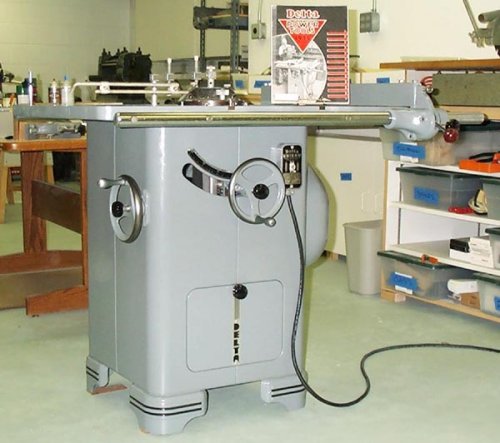 This is the same saw shown at the top of this article. The restoration took just over a month of weekends and some week nights. It was time well spent |